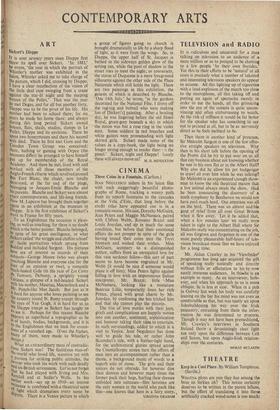CONTEMPORARY ARTS
ART
Sickert's Dieppe
IT is over seventy years since Dieppe first iP threw its spell over Sickert. 'In 1883,' he wrote, 'the year in which the portrait of Whistler's mother was exhibited in the Salon, Whistler asked me to take charge of the picture, which I did, crossing by Dieppe. I have a clear recollection of the vision of the little deal case swinging from a crane against the star-lit night and the sleeping , houses of the Pollet.' That was the year
he met Degas, and for all but another forty,
e Dieppe was to be the pivot of his life. His mother had been to school there; for six 'he Years he made his home there; and always val during this long period Sickert owned Iii houses, flats, sheds, studios, dumps in Le Pellet, Dieppe and its environs. There he spent two honeymoons and there his second Wife died. There he first met Gore and the Camden Town Group was conceived; there, bathing or gaming with Orpen (the accounts differ) he arranged to have himself Id put up for membership of the Royal Academy. And there he met, lived with and worked with all those members of the .0i
bas coterie which revolved around Bas Fort Blanc, the chalet, now totally destroyed, at the far end of the plage, belonging to Jacques-Emile Blanche and his parents. Blanche and Sickert were almost
tht exact contemporaries, and life-long friends. 01 Now M. Lapeyre has brought them together again in an exhibition at the museum in Dieppe. It is the first exhibition of Sickert'i work in France for fifty years. To an Englishman the occasion is pleas- ing, as well-as touching, for there is no'doubt Which is the better painter. Blanche belonged, 1,11 spite of his great intelligence, to what Sickert called ' the wriggle and chiffon school' of facile portraitists which sprang from uoldini and- included Sargent. His pictures here are of interest as records of their subjects—George Moore (who was always
jtig' touching Blanche and everyone else for the 31.1 loan of an opinion or two), a romantic
black-hatted Gide (in the year of Les Caves 5,11 Vatican), Debussy, a ,sprightly young Coiteau, a glimpse of a red-headed Sickert with his mother, Mauriac, Maeterlinck and a 1111l% Punch-like Max Jacob. But just as it ; Is hard for anyone who loves painting to see
the country round St. Remy except through
the eyes of Van Gogh, it is hard for us to !CC Dieppe except as Sickert has taught us
'0 see it. erhaps this reason
!IPPears as P superficialfor a topographer asBlanche he Is of hands, bodies, backgrounds, and it is 1° the Englishman that we look for evoca- tions of a vanished age. (Even the frames, es ignyo of them, were made to Whistler's , \
: What an extraordinary mass of contradic-
he lions Sickert was! The fastidious man-of- the-world who loved life, secretive yet with 4 Passion for striking public attitudes, the itY occur who took his work with such deadly I17, that un-British seriousness. Let. us not forgeti ``tat he had played with Irving and Mrs.
an Kendall and at Sadler's Wells. In his earlier work—say up to 1910—an intense
i10 reticence is combined with a theatrical sense °,,_t tight which dramatises every scene he depicts. There is a Venice picture in which : a group of figures going to church is brought dramatically to life by a sharp flood of light, as it were from the wings. So, in Dieppe, the upper half of St. Jacques is bathed in the sideways golden glow of the setting sun, while the pool of shadow in the street rises to meet the night; or conversely, the statue of Duquesne is a mere foreground silhouette against the other side of the Place Nationale which still holds the light. There are two paintings in this exhibition, the genesis of which is described by Blanche. 'One 14th July,' he wrote, 'in the gardens decorated for the National Fete, I drove off the rag-tag and bobtail who were making fun of [Sickert's] painting. After a broiling day, he was lingering before the old Hotel Royal, green-grey beneath a sky in which the moon was but a rose ring in the violet mist. Some soldiers in red breeches and white gaiters were promenading with light skirted girls. Sickert made notes of the values in a copy-book, the light being no longer strong enough to render them ( n the panel.' Sickert, night and Dieppe! Surely these will always move us? M. H. MIDDLETON


































 Previous page
Previous page